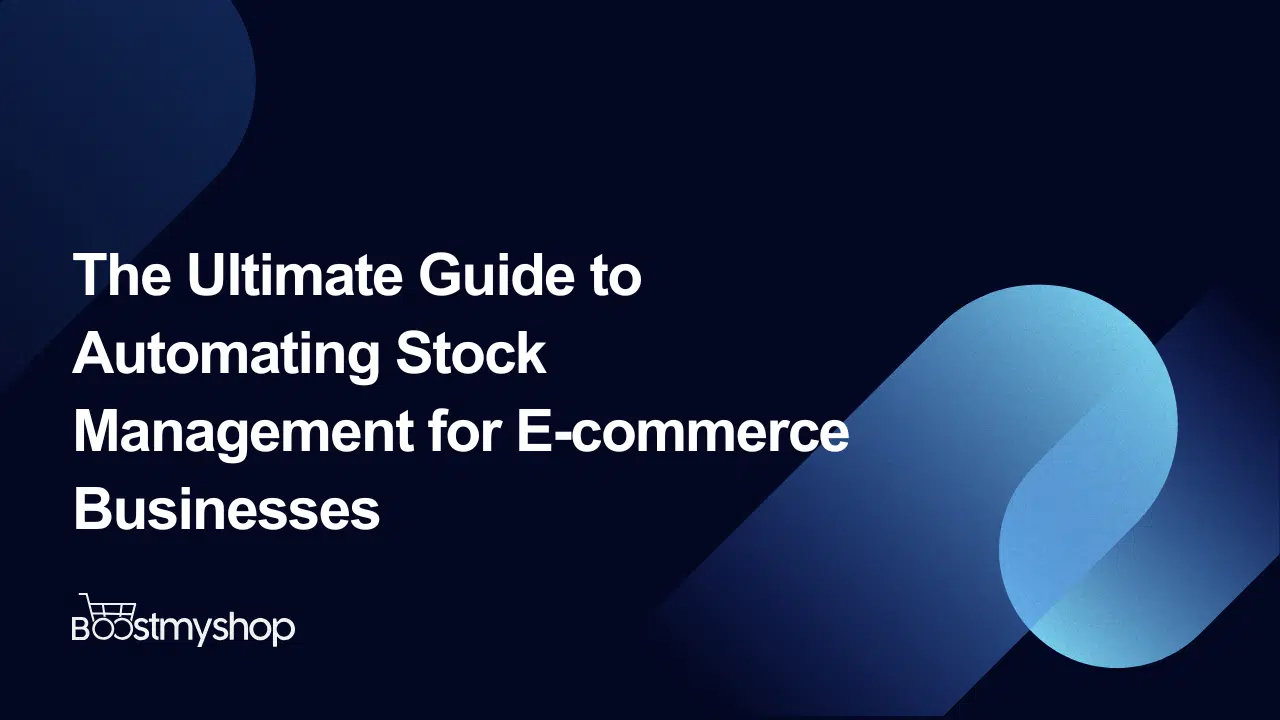The Ultimate Guide to Automating Stock Management for E-commerce Businesses
Introduction
Automating Stock Management
Stock management is one of the most critical yet challenging aspects of running a successful e-commerce business. A 2023 study by Statista revealed that inventory mismanagement contributes to 43% of lost sales in online retail. This issue often stems from inaccurate stock counts, delayed updates, and manual errors, all of which can lead to stockouts, overstocking or unmet customer expectations.
For e-commerce businesses striving to remain competitive, automating stock management has become indispensable. The global market for inventory management software is projected to grow at a CAGR of 10.2% from 2023 to 2030 (source: Grand View Research), highlighting the increasing reliance on automation to tackle inventory challenges.
Automate Stock Management solutions provide real-time visibility into stock levels, streamline order fulfillment, and reduce the risk of human errors. These tools are designed to cater to businesses of all sizes, from small online shops to multi-channel retail giants, ensuring scalability as operations grow.
By automating stock management, businesses can not only save time and resources but also focus on delivering better customer experiences, boosting profitability, and staying ahead of their competition in today’s dynamic market.
This guide will walk you through everything you need to know about automating stock management, its benefits, tools, and actionable strategies to optimize your inventory processes.
At Boostmyshop, our solution MyFulfillment is tailored to help e-commerce businesses streamline stock management, improve efficiency, and enhance operational control. Whether you’re a small retailer or a large enterprise, MyFulfillment provides the tools you need to succeed.
What is Stock Management Automation?
Stock management automation refers to the use of technology and software to streamline and optimize the processes of tracking, controlling, and replenishing inventory levels. Instead of relying on manual methods, which are prone to errors and inefficiencies, automated systems enable businesses to manage their inventory in real time with minimal human intervention.
At its core, stock management automation leverages tools like Inventory Optimization Software to monitor stock levels, track item movements, predict restocking needs, and synchronize inventory across multiple sales channels. These systems utilize advanced algorithms and data analytics to ensure businesses always have the right stock at the right time.
For instance, automation tools can send alerts when inventory dips below a specified threshold, initiate reorders with suppliers, and even distribute inventory intelligently across warehouse based on demand patterns. This eliminates the risk of stockouts or overstocking, which can impact profitability and customer satisfaction.
Technology also plays a significant role in streamlining inventory operations by integrating with e-commerce platforms, point-of-sale (POS) systems, and warehouse stock management tools. By connecting these systems, businesses gain real-time visibility into their inventory, enabling more informed decision-making and efficient operations.
Whether it’s automating purchase orders or optimizing stock levels using predictive analytics, Inventory Optimization Software helps businesses save time, reduce costs, and maintain a seamless supply chain-ultimately enhancing overall efficiency and scalability.
What to Look for in Inventory Optimization Software?
While choosing a stock management automation tool, it’s essential to evaluate the features that align with your business needs. Here are the key features every effective solution should offer:
Real-Time Tracking
Real-time tracking is at the heart of stock management automation. With live updates on inventory levels across multiple sales channels, businesses can avoid discrepancies, stockouts, and overstocking. For instance, when an item sells on Shopify, the system should automatically adjust stock levels on other platforms like Amazon or Magento. Real-time tracking ensures that data remains consistent and actionable, reducing errors caused by manual updates.
Predictive Analytics
Predictive analytics, powered by Predictive Inventory Management Tools, uses historical data and trends to forecast demand. This feature helps businesses plan for peak seasons, promotions, or unexpected surges in orders. Predictive tools also minimize deadstock by suggesting optimal reorder quantities and frequencies, ensuring a lean and efficient inventory.
Seamless Integrations
Effective automation tools should integrate effortlessly with e-commerce platforms like Shopify, WooCommerce, and Magento, as well as third-party logistics (3PL) providers and point-of-sale (POS) systems. These integrations create a unified ecosystem, allowing businesses to synchronize stock levels, manage orders, and streamline operations without juggling multiple tools.
Scalability
As businesses grow, their stock management needs become more complex. An effective tool should adapt to handle increasing sales volumes, new product lines, and multi-warehouse setups. Scalability is also vital during seasonal fluctuations, enabling businesses to maintain optimal stock levels without additional manual effort.
User-Friendly Interfaces
A user-friendly interface ensures that teams can quickly adopt the tool with minimal training. Intuitive dashboards, customizable workflows, and easy-to-navigate menus reduce the learning curve, making stock management accessible to both small and large teams.
Key Benefits of Automating Stock Management
Accuracy and Efficiency
Manual inventory management is prone to errors, whether it’s incorrect stock counts, misplaced items, or delayed updates. Automating stock management drastically reduces human errors by providing real-time data updates and ensuring consistency across platforms.
According to a 2022 report by McKinsey, businesses that adopted automated inventory systems saw a 30% improvement in data accuracy, leading to fewer stock discrepancies and better operational efficiency.
Time-Saving
By automating repetitive tasks like stock level monitoring, reordering, and generating inventory reports, businesses can save valuable time. This allows employees to focus on higher-value activities, such as improving customer service or strategizing for growth.
A case study by Shopify revealed that businesses using inventory automation tools saved an average of 20 hours per month, significantly reducing administrative burdens.
Improved Decision-Making
Automation tools equipped with Predictive Inventory Management Tools utilize historical sales data and market trends to forecast demand accurately. This enables businesses to plan for high-demand periods, avoid shortages, and minimize excess inventory.
Predictive analytics can increase forecasting accuracy by up to 85%, as noted in a study by Deloitte, resulting in smarter, data-driven decisions.
Cost Efficiency
Overstocking ties up capital and increases storage costs, while stockouts lead to lost sales and dissatisfied customers. Automated systems prevent both scenarios by optimizing inventory levels.
Businesses using such systems report a 10-15% reduction in inventory holding costs, according to a 2023 Logistics Tech survey.
How to Choose the Right Inventory Optimization Software
Selecting the right inventory optimization software is a crucial decision for e-commerce businesses. The right tool can streamline operations, improve efficiency, and support long-term growth. Here’s how to make an informed choice:
Evaluate Your Business Needs
Start by identifying your unique requirements. Are you managing inventory across multiple channels, such as Shopify, Amazon, and WooCommerce? Do you operate a single warehouse or multiple fulfillment centers? For businesses with large inventories or high sales volumes, scalability is critical. If you’re focused on demand forecasting, look for tools with robust predictive analytics capabilities.
Compare Features, Pricing, and Integrations
Create a checklist of must-have features, such as real-time tracking, automated reordering, and multi-channel integration. Compare tools based on these features and ensure compatibility with your existing systems, such as point-of-sale (POS) software or warehouse management systems. Pricing is another key factor-evaluate not only the upfront costs but also subscription fees and hidden charges.
Explore Popular Software Options
MyFulfillment by Boostmyshop: Tailored for e-commerce, offering seamless integration with major platforms and advanced automation capabilities.
Test Trial Periods and Evaluate Support
Most software providers offer free trials. Use this time to explore the interface, test core features, and evaluate performance. Additionally, assess the quality of customer support. A responsive and knowledgeable support team can make a significant difference, especially during onboarding or troubleshooting.
Consider Long-Term Scalability
Choose a solution that grows with your business. Tools with flexible plans and customizable features ensure that you won’t outgrow the software as your business expands.
Implementation Guide for Automating Stock Management
Automating stock management is a transformative step for any e-commerce business, but successful implementation requires careful planning and execution. Here’s a step-by-step guide to ensure a smooth transition:
Audit Your Current Inventory Processes
Begin by analyzing your existing inventory management practices. Identify pain points such as manual errors, delayed stock updates, or inefficient tracking methods. Map out your workflows, from stock procurement to order fulfillment, and determine where automation can add the most value. This audit provides a baseline for measuring the effectiveness of automation post-implementation.
Choose the Right Tool
Look for tools with features like real-time tracking, predictive analytics, and multi-channel integration. Solutions like MyFulfillment are particularly effective for e-commerce businesses, offering seamless integration with major platforms and advanced automation capabilities.
Train Your Team for Adoption
Even the best tools require user adoption to deliver results. Organize training sessions for your team to familiarize them with the software’s features and interface. Emphasize how automation will simplify their tasks, reduce manual workload, and enhance overall efficiency. Encourage feedback to address any concerns early in the process.
Monitor KPIs and Optimize
Track key performance indicators (KPIs) such as stock turnover ratio, forecast accuracy, and order fulfillment speed. Use these metrics to evaluate the effectiveness of the new system and identify areas for further optimization. Regular monitoring ensures that the system continues to deliver value as your business evolves.
Overcoming Implementation Challenges
Transitioning to automation may involve challenges such as initial resistance from staff, data migration issues, or integration hurdles. To overcome these:
- Staff Resistance: Highlight the benefits of automation through hands-on demonstrations and success stories.
- Data Migration: Work with your software provider to ensure accurate and seamless data transfer.
- Integration Hurdles: Choose software with robust customer support and integration capabilities.
Ready to Automate Your Stock Management?
Implementing stock management automation doesn’t have to be overwhelming. With the right tools and guidance, your business can seamlessly transition to a system that saves time, reduces errors, and scales effortlessly.
Book a call with our expert team today to learn how MyFulfillment can be implemented effortlessly into your operations. Let us help you automate, streamline, and elevate your ecommerce to the next level.
Book a Demo Now
Future of Stock Management in E-commerce
As e-commerce continues to evolve, the future of stock management lies in leveraging cutting-edge technologies to create smarter, more efficient systems. Automation, artificial intelligence (AI), and machine learning are at the forefront of this transformation. These technologies enable e-commerce businesses to process vast amounts of data, predict trends, and make proactive decisions in real-time.
AI and Predictive Analytics
Predictive Inventory Management Tools will play an increasingly vital role in future strategies. By analyzing historical sales data, market trends, and even external factors like weather or economic shifts, these tools provide businesses with accurate demand forecasts. This reduces the risk of overstocking or stockouts and ensures optimal inventory levels at all times.
Integration with Advanced Technologies
The integration of automation tools with emerging technologies such as the Internet of Things (IoT) and blockchain will redefine inventory management. IoT-enabled sensors can track inventory movement in real-time, providing precise location and condition updates. Meanwhile, blockchain ensures secure and transparent supply chain processes, building trust with partners and customers alike.
Sustainability and Efficiency
Future stock management systems will also focus on sustainability, helping businesses reduce waste and minimize their carbon footprint. Automation will enable smarter resource allocation and inventory planning, aligning with both cost efficiency and environmental goals.
Embracing these advancements will allow e-commerce businesses to stay competitive in an increasingly complex and dynamic market.
Conclusion
Automating stock management is no longer a luxury but a necessity for e-commerce businesses aiming to stay competitive in today’s fast-paced market. By implementing inventory optimization software and predictive inventory management tools, businesses can achieve unparalleled efficiency, accuracy, and scalability. Automation eliminates manual errors, streamlines inventory tracking, and ensures stock levels are optimized to meet demand without overstocking or stockouts.
The integration of advanced technologies like AI and predictive analytics provides valuable insights, enabling businesses to make data-driven decisions and stay ahead of trends. Additionally, automation saves time, reduces costs, and enhances customer satisfaction by ensuring faster, error-free order fulfillment.
The time to act is now.
Explore the possibilities of advanced inventory management solutions and unlock the full potential of your e-commerce operations.
[maxbutton id=”1″ url=”https://www.boostmyshop.com/features/order-fulfillment-boostmyshop-myfulfillment/schedule-a-free-demo-of-boostmyshop-myfulfillment/” text=”Book a Demo Now” ]
 Automating Stock Management
Automating Stock Management

